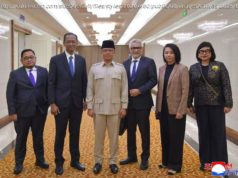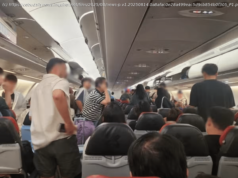What does that mean?
On Wednesday, after conducting its longest-range missile test yet, North Korea declared itself a globe-spanning nuclear-weapons power and insisted the United States deal with it on those terms. Kim Jong Un’s government claimed that it had launched a new type of intercontinental ballistic missile (ICBM)—a “Hwasong-15”—capable of “carrying [a] super-heavy [nuclear] warhead and hitting the whole mainland of the U. S.” It quoted the Dear Leader, who announced that his nation had “finally realized the great historic cause of completing the state nuclear force.”
So… do we all go home now? Is that how this ends—with North Korea sprinting across the finish line, the United States panting behind it, and the two countries learning to deter one another just as nuclear-armed states have since Little Boy and Fat Man fell on Hiroshima and Nagasaki?
Donald Trump, for his part, isn’t conceding defeat. “This situation will be handled!” he tweets, promising tougher international sanctions against the North. Top officials in his administration, including the national-security adviser, the CIA director, and the president himself, have repeatedly stated that North Korea must be prevented—by all means necessary, including military action—from developing the means to place a nuclear warhead on a long-range missile that can reach the United States. They’ve argued that a world in which Kim Jong Un’s rogue regime can hold the U. S. government hostage with the threat of nuclear war—or worse still, actually fire those nukes at Americans—is unacceptable.
But North Korea’s message this week boils down to this: It’s no use shutting the doors when the horse has already left the barn.
North Korea’s Boldest Missile Test Yet
“We’re now at a point where they have tested an ICBM that can clearly hit the U. S.… They’ve tested a nuclear weapon that had a couple hundred kilotons’ yield, which they say is a miniaturized thermonuclear weapon, which kind of looks like a miniaturized thermonuclear weapon to me,” said Jeffrey Lewis, the director of the East Asia Nonproliferation Program at the Middlebury Institute of International Studies at Monterey. “It’s done. It’s over.”
The window for stopping North Korea from acquiring the capacity to threaten the U. S. mainland with nukes slammed shut on July 4, when North Korea tested its first ICBM, the Hwasong-14, Lewis argued. “The whole point of a preventive war is to do it before they get the nuclear weapons. If you do it after, it’s just a plain old nuclear war.”
When Kim Jong Un speaks of “completing the state nuclear force,” Lewis reckons that he is referring to meeting all the milestones—the Hwasong-12, -14, and -15— in a missile-development program that the Kim government committed to some time ago, similar to how China followed a plan called “ four missiles in eight years ” in the 1960s. Details are still emerging about the latest missile test, but what Lewis finds most significant so far is that North Korea claims to have fired the Hwasong-15 from an 18-wheel truck that it manufactured itself, rather than relying on 16-wheel trucks from China that it had used for its two previous ICBM tests in July. That means depriving North Korea of road-mobile launch pads is no longer as simple as demanding that China stop selling big trucks to its neighbor. And it enables the North Koreans to build more long-range missiles since they’re no longer restricted to missiles small enough to fit on imported Chinese vehicles.
“In my conversation with the North Koreans, they’ve been very clear that their key goal is to demonstrate they’re capable of striking the continental U. S. with a nuclear-tipped missile” in order to deter a U. S. attack, said Suzanne DiMaggio of New America, who has participated in a series of unofficial nuclear talks with North Koreans affiliated with the Kim government. “They have told us that their goal is not to amass a giant nuclear arsenal, but to have just enough to safeguard the regime, and then they will turn their attention to economic development of the country. Of course, this is what they told us. We should fully test that.”
“This most recent launch tells us they’re well on their way to achieving that goal,” DiMaggio said.
These advances, however, don’t necessarily indicate that North Korea is done with its nuclear and missile tests. “This isn’t like, ‘We hit our goal. It’s good.’ It’s like, ‘We hit our goal. Suck it,’” Lewis told me. “It’s triumphal.” He expects North Korea to continue experimenting with the Hwasong-15, solid-fuel long-range missiles (the long-rage tests so far have involved liquid fuel), and underground nuclear tests. He can even imagine North Korea test-firing a missile with a nuclear warhead into the ocean, as the Americans, Chinese, and Russians did in the 20th century, if the Kim government feels the need to extinguish doubts about its nuclear capabilities. (While North Korean officials have threatened to detonate a nuclear weapon over the Pacific Ocean, DiMaggio suspects that they won’t follow through with it because it would carry too great a risk of retaliation by the United States or other countries.)
“Virtually no one finishes their nuclear-weapons program and [says], ‘Well, our work is done here,’” Lewis noted.
Nor does virtually any country negotiate away a nuclear arsenal as advanced as North Korea’s is now. “The North Koreans are not giving up their nuclear weapons,” said Lewis. They appear willing to talk, but not about the U. S. government’s goal of removing nuclear weapons from North Korea. DiMaggio believes Kim Jong Un may make an even grander declaration about the completion of North Korea’s nuclear force during his New Year’s address or the Winter Olympics in South Korea in February, and then express willingness to “return to the negotiating table to try to extract an array of security and economic concessions” from the United States and its partners.
But if the “completion” of North Korea’s nuclear program changes anything, Lewis argued, it’s less that it will make North Korean leaders more open to talks than that it should encourage U. S. leaders to “accept that [North Korea] can target the United States with nuclear weapons” and to lower their expectations for what diplomacy can achieve.
“Even though [America’s North Korea] policy has failed miserably, and we find ourselves in this really undesirable situation with a nuclear-armed North Korea, we still have interests,” Lewis said.






